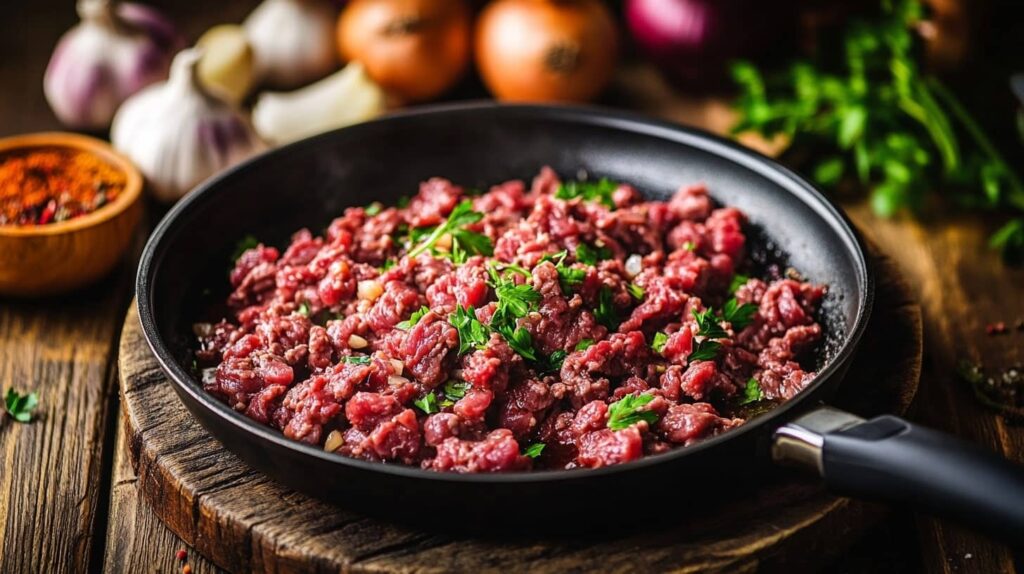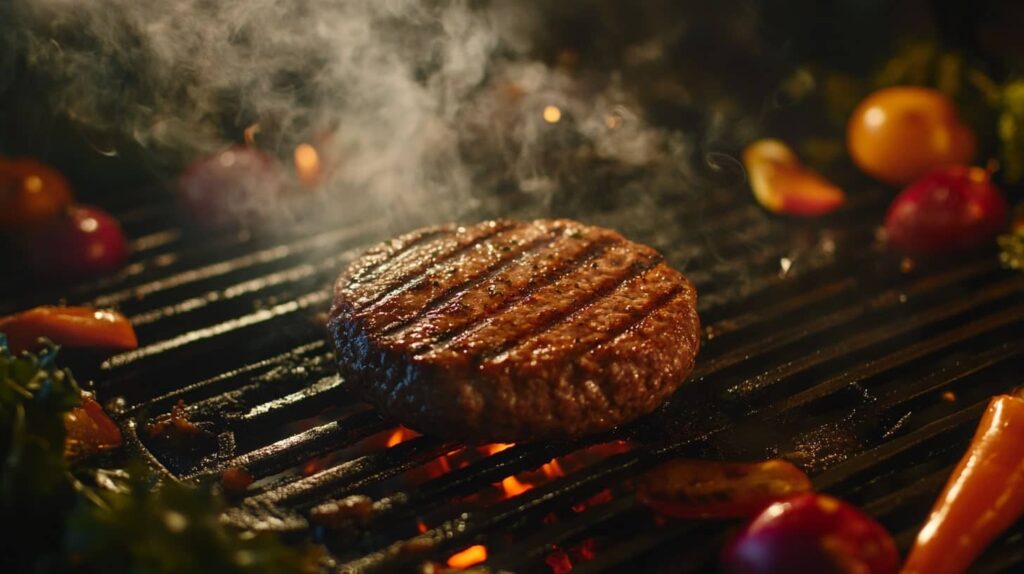
Minced beef nutritional value makes it one of the most versatile and nutrient-packed ingredients in any kitchen. It’s loaded with high-quality protein, essential vitamins, and minerals like iron and zinc—perfect for building muscle, boosting energy, and supporting immunity. But is minced beef as healthy as it seems? Let’s dive deep into its nutritional benefits, potential risks, and smart ways to include it in your diet!
Table of contents
Introduction to Minced Beef and Its Popularity
Minced beef is a household favorite. From juicy burgers to hearty pasta sauces, this versatile ingredient has earned its spot in kitchens worldwide. But have you ever wondered why it’s so popular? The answer lies not just in its taste but also in its impressive nutritional profile.
What Is Minced Beef? A Quick Overview
Minced beef, often called ground beef, is simply beef that has been finely chopped using a grinder or knife. It can come from different cuts, including chuck, sirloin, or brisket, giving it varying fat content and flavor.
Key Characteristics:
- Available in different fat percentages (e.g., 80/20, 90/10).
- Easily cooked into various dishes like tacos, lasagna, and meatloaf.
- Affordable, making it accessible for most households.
“Minced beef isn’t just food; it’s fuel for your body.”
Why Is Minced Beef a Popular Protein Source?
The secret to minced beef’s popularity lies in its high protein content and rich flavor. It’s easy to cook, pairs well with spices, and suits multiple cuisines. Whether you’re on a muscle-building diet or simply want a hearty meal, minced beef fits right in.
Did You Know?
👉 Ground beef makes up over 40% of total beef sales in the U.S., showing its widespread appeal.
Nutritional Composition of Minced Beef

Let’s talk numbers. What makes minced beef nutritional value so impressive? Check out its breakdown below:
Macronutrients in Minced Beef: Proteins, Fats, and Carbohydrates
| Nutrient | Amount per 100g (80/20 ground beef) |
|---|---|
| Calories | 250 kcal |
| Protein | 20 g |
| Total Fat | 20 g |
| Saturated Fat | 8 g |
| Carbohydrates | 0 g |
| Cholesterol | 70 mg |
Minced beef is carb-free, making it perfect for low-carb and ketogenic diets. It’s also protein-dense, promoting muscle repair and growth.
“Think of protein as the bricks that build your body—minced beef provides plenty of them!”
Micronutrients in Minced Beef: Vitamins and Minerals
| Vitamin/Mineral | Amount per 100g | % Daily Value (DV) |
|---|---|---|
| Iron | 2.6 mg | 15% |
| Zinc | 4.5 mg | 41% |
| Vitamin B12 | 2.4 µg | 100% |
| Niacin (B3) | 4.5 mg | 28% |
| Selenium | 14 µg | 25% |
Minced beef is rich in iron, which prevents anemia, and zinc, which boosts immunity. It also packs Vitamin B12, vital for brain health and energy production.
Caloric Content: Is It Too High?
Calories in minced beef depend on its fat content. Leaner options (e.g., 90/10) contain fewer calories but also less flavor. If you’re watching your calorie intake, opt for leaner versions or drain excess fat after cooking.
Health Benefits of Consuming Minced Beef
Minced beef nutritional value isn’t just about taste—it’s incredibly nutritious. Let’s explore the health benefits it offers:
1. Muscle Building and Protein Enrichment
Protein is the building block of muscles, and minced beef delivers it in abundance. Athletes and fitness enthusiasts often include it in their diets to repair muscles after workouts.
“Eating minced beef is like giving your muscles the tools they need to rebuild stronger!”
2. Iron Absorption and Anemia Prevention
Iron in minced beef is heme iron, which your body absorbs more efficiently than non-heme iron found in plants. This makes it excellent for people prone to anemia.
3. Boosting Immunity with Zinc and B Vitamins
Zinc strengthens your immune system, while B vitamins enhance energy production and brain function. Including minced beef in your diet helps maintain overall health and keeps your defenses strong.
4. Supports Weight Loss and Low-Carb Diets
Because minced beef has zero carbs and high protein, it’s ideal for keto and low-carb diets. Protein keeps you full longer, reducing cravings and calorie intake.
“Who said weight loss had to be boring? Minced beef brings flavor and fitness together!”
Potential Health Concerns Associated with Minced Beef
While minced beef nutritional value offers numerous benefits, it’s important to consider the potential risks.
Saturated Fats and Cholesterol: Are They Harmful?
Minced beef contains saturated fats, which, if consumed excessively, may increase the risk of heart disease. Opt for leaner versions to cut down fat without losing protein.
Preservatives and Additives in Processed Minced Beef
Store-bought minced beef may include preservatives to extend shelf life. Always check labels for added ingredients and choose fresh, organic options when possible.
Overconsumption and Red Meat Risks
Eating too much red meat has been linked to health concerns like inflammation and colorectal cancer. Moderation is key—balance minced beef with vegetables and grains.
“Minced beef is great, but balance is everything—treat it as part of a healthy mix.”
Choosing High-Quality Minced Beef: What to Look For
Not all minced beef is created equal. The quality of your meat can make a big difference in both flavor and nutrition. Here’s how to pick the best:
Organic vs. Conventional Minced Beef
- Organic Beef: Comes from cattle raised without antibiotics or hormones. It’s often grass-fed, making it richer in omega-3 fatty acids and antioxidants.
- Conventional Beef: May contain traces of antibiotics and growth hormones. It’s cheaper but less nutrient-dense.
“If you can, go organic—it’s better for your body and the planet!”
Grass-Fed vs. Grain-Fed: Nutritional Differences
| Type | Benefits |
|---|---|
| Grass-Fed | Higher in omega-3s, vitamin E, and CLA (Conjugated Linoleic Acid) for heart health. |
| Grain-Fed | Higher in fat content, giving a richer flavor but slightly fewer nutrients. |
Grass-fed beef is often considered healthier, but grain-fed beef is juicier—so it depends on your priorities!
Labels and Certifications: Ensuring Quality and Safety
Look for these labels to guarantee you’re getting safe and high-quality minced beef:
- USDA Certified Organic: Ensures no hormones or antibiotics were used.
- Grass-Fed Label: Guarantees cattle were raised on pasture.
- Non-GMO Verified: Confirms no genetically modified feeds were used.
- Certified Humane: Indicates ethical farming practices.
“Read the labels—it’s like checking the report card of your beef!”
Cooking Methods That Retain Nutritional Value

Cooking minced beef the right way can make all the difference. Here’s how to prepare it without sacrificing its nutrients:
Best Cooking Techniques: Grilling, Baking, and Stir-Frying
- Grilling: Locks in flavor and reduces excess fat. Perfect for burgers and kebabs.
- Baking: Great for casseroles and meatloaf, as it retains moisture.
- Stir-Frying: Quick and easy, ideal for tacos, stir-fries, and pasta sauces.
“Cooking minced beef should feel like art—flavor and nutrition combined!”
Avoiding Nutrient Loss During Cooking
- Use Low Heat: Prevents overcooking and nutrient loss.
- Drain Excess Fat: Keeps calories in check without compromising flavor.
- Add Vegetables: Boosts fiber and vitamins while complementing beef’s taste.
Healthy Recipes Using Minced Beef
1. Beef and Vegetable Stir-Fry 🥦🥩
- Ingredients: Minced beef, broccoli, carrots, soy sauce, garlic, and sesame oil.
- Method: Stir-fry vegetables, add beef, and cook until browned. Toss in soy sauce for flavor.
2. Zucchini Beef Boats 🥒
- Ingredients: Zucchini, minced beef, tomato sauce, and cheese.
- Method: Hollow out zucchinis, stuff them with seasoned beef, top with cheese, and bake.
3. Spicy Beef Lettuce Wraps 🥬🌶️
- Ingredients: Minced beef, chili, garlic, hoisin sauce, and lettuce leaves.
- Method: Cook beef with spices and sauces. Serve wrapped in lettuce for a low-carb treat!
“Healthy doesn’t have to mean boring—try these recipes to spice things up!”
Common Problems and Solutions in Storing and Handling Minced Beef

Proper storage and handling are crucial to avoid spoilage and contamination.
How to Store Minced Beef Safely
- Refrigerator Storage: Keep it at 40°F (4°C) or below. Use within 1–2 days.
- Freezing: Wrap tightly in freezer-safe bags. It lasts 3–4 months in the freezer.
Pro Tip: Divide larger portions into smaller packs for easy thawing later!
Detecting Spoiled Minced Beef
Signs your minced beef has gone bad:
- Color Change: Turns gray or brown.
- Unpleasant Smell: Sour or rotten odor.
- Slimy Texture: Sticky or slippery surface.
“When in doubt, throw it out—don’t risk food poisoning!”
Freezing Tips to Retain Freshness and Flavor
- Use Airtight Bags: Prevents freezer burn.
- Label with Dates: Keep track of storage time.
- Thaw in the Fridge: Avoid leaving it out at room temperature.
“A little prep goes a long way—frozen minced beef can save dinner in a pinch!”
Is Minced Beef Suitable for All Diets?
Low-Fat Diets: Can You Still Eat Minced Beef?
Yes! Opt for 90/10 lean beef to cut down on fat while still getting protein.
Minced Beef for Keto and High-Protein Diets
Perfect for low-carb diets, minced beef keeps you full without spiking blood sugar levels.
Vegetarian and Vegan Alternatives to Minced Beef
For non-meat eaters, try:
- Lentils or Mushrooms: Great for texture and nutrients.
- Soy or Tofu Crumbles: Mimic the look and feel of beef.
- Plant-Based Mince: High-protein alternatives like Beyond Meat.
“Meatless doesn’t mean tasteless—try these swaps for guilt-free meals!”
Sustainability and Environmental Impact of Minced Beef Production
Minced beef may be a nutritional powerhouse, but its production raises questions about sustainability. Let’s look at the facts and solutions for eco-conscious consumers.
The Carbon Footprint of Beef Production
Beef production accounts for approximately 14.5% of global greenhouse gas emissions, primarily due to methane emissions from cows. This makes it one of the biggest contributors to climate change.
“Eating beef isn’t just about taste—it’s about responsibility.”
Key Environmental Concerns
- Water Usage: Producing 1 kg of beef requires approximately 15,000 liters of water—a significant resource demand.
- Land Degradation: Livestock farming contributes to deforestation and habitat loss in many regions.
- Waste Management: Animal waste pollutes waterways, leading to water contamination and harming aquatic life.
Ethical Concerns and Sustainable Farming Practices
Consumers today are more concerned about animal welfare and ethical farming practices. To address this:
- Farmers are adopting regenerative agriculture, which improves soil health and reduces carbon emissions.
- Some brands focus on grass-fed and pasture-raised beef, reducing reliance on grain feed and synthetic fertilizers.
“It’s not about quitting beef—it’s about choosing better beef!”
Future Trends: Lab-Grown and Plant-Based Alternatives
The future of minced beef may look very different:
- Lab-Grown Meat: Scientists are producing cultured beef in labs using animal cells—no slaughter involved.
- Plant-Based Meat Alternatives: Brands like Beyond Meat and Impossible Foods mimic the taste and texture of real beef with less environmental impact.
“The future of beef could be guilt-free—exciting, right?”
FAQs About Minced Beef Nutritional Value
Let’s answer some of the most common questions about minced beef!
1. Is Minced Beef Healthier Than Other Types of Beef?
Minced beef can be just as healthy as steak or roasts, depending on its fat content. Leaner options, like 90/10 beef, are lower in calories but still rich in protein.
2. How Much Protein Does Minced Beef Contain per Serving?
A 100g serving of minced beef typically contains 20-25 grams of protein, making it an excellent source for muscle growth.
“That’s like a mini protein shake on your plate!”
3. Can Minced Beef Be Included in a Weight Loss Diet?
Absolutely! Opt for lean minced beef and pair it with vegetables to create low-calorie, high-protein meals. It helps keep you full longer, reducing cravings.
4. What Are the Healthiest Ways to Prepare Minced Beef?
- Grilling and baking are the healthiest methods since they require little to no added fat.
- Avoid deep-frying to cut back on unnecessary calories.
5. How Does Cooking Affect Minced Beef Nutrition?
Cooking reduces fat content as excess oil drips away, but it may also lower vitamin B levels. To retain nutrients, cook on low heat and avoid overcooking.
6. Are There Any Preservative-Free Minced Beef Options?
Yes! Look for fresh, organic, or grass-fed beef labeled preservative-free. Better yet, ask your butcher to grind fresh beef cuts for you.
Explore More Delicious Recipes and Cooking Guides!
Looking for more ways to enjoy minced beef and other tasty recipes? Check out these helpful guides and recipes from our website to keep your culinary journey exciting:
- Understanding Beef Tips: A Comprehensive Beef Tips Guide – Learn all about beef tips, their uses, and how to make them tender and flavorful.
- Stew Meat vs. Beef Tips: Differences, Uses, and Best Recipes – Discover the key differences between stew meat and beef tips, along with recipes to try at home.
- How to Make Healthy Mincemeat That Everyone Will Love – Create healthy and flavorful mincemeat dishes that everyone can enjoy without guilt.
These resources will help you take your cooking skills to the next level and explore new recipes packed with flavor and nutrition!
Conclusion: Balancing Nutrition and Taste with Minced Beef
Minced beef is a nutritional powerhouse packed with protein, iron, and vitamins that support a healthy lifestyle. Its versatility in cooking makes it a staple ingredient, whether you’re making burgers, tacos, or meatballs.
While it’s rich in nutrients, it’s essential to balance consumption to avoid excess saturated fat and environmental impacts. By choosing lean cuts, organic options, and sustainable sources, you can enjoy minced beef guilt-free.
